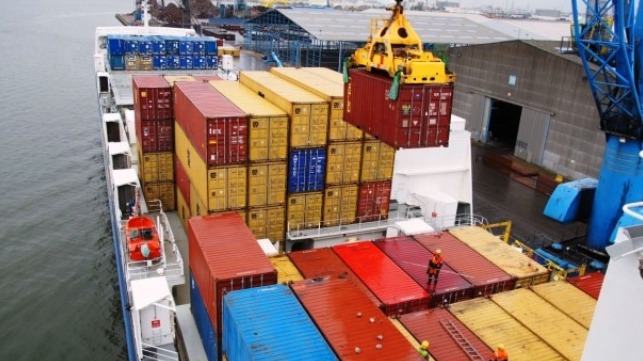Evolving International Container Markets Follow U.S. Lead

Two distinct markets are evolving in international container transportation with one market seeking faster delivery despite having to pay premium prices and a second market that is willing to delay delivery in exchange for lower transportation costs.
Investment and Market
During an earlier time when smaller ships sailed via the Panama Canal, larger container ships began to enter service on trans-Pacific routes. Containers from Asian origins arrived at West Coast North American ports, with a portion of containers loaded on to trains that traveled across to east coast destinations. Studies undertaken by American transportation research groups such as Sea Point revealed that ships could sail longer distances and incur lower per-container-transportation costs than railways that could offer faster delivery schedules, at higher per-container-transportation costs. The result was the rebuilding of the Panama Canal to transit larger container ships.
There were transportation analysts who believed that there was a market for larger container ships that could sail via the Panama Canal to east coast North American ports and deliver containers at substantially lower costs than the combination of an even larger ship arriving at a west coast port and a transcontinental train. The success at Port of Newark in regard to arrivals of larger container ships from Asia verifies the existence of the market for lower transportation costs of containers.
Railway Developments
North American railways have responded to the challenge of offering more competitive per-container transportation costs on transcontinental container trains by increasing the number of containers that each train can carry. Many decades ago, some railways that carried ore and other bulk freight developed methods by which to operate multiple locomotives spread through the length of each train. The railways have now adapted that operational precedent for extended length container trains pulled by a few locomotives at the front and assisting locomotives coupled near the middle of a train of over 240 carriages carrying double-stacked 40-foot containers (up to 960 TEUs).
While some of these extended length container trains operate between North American west and east coasts, some west coast ports are approaching their operational capacity and opening new opportunity at east coast ports. Port of Newark does a brisk business transferring containers from new-generation neo-Panamax ships to extended-length container trains that deliver to destinations located within 500 miles of that port. The precedent forms the business case for proposed and competing container ship – railway intermodal transfer terminals to be located in Eastern Canada at Saint John, Quebec City and at Cape Breton (Melford).
Euro-Asian Development
The increase in maritime container trade between China and Western Europe and more recently between India and Western Europe has created a sub-market that is willing to pay higher tariffs for faster delivery. As a result, parallel railway links are being developed across Asia and across Russia that connect between China and Europe. The rail line via Russia requires a change of railway wheel assemblies due to different railway gauges. A railway line built to the international railway gauge that connects between Tehran and Beijing via Turkmenistan and Uzbekistan was completed several years ago.
While Iran and Turkey share a border and operate the identical railway gauge, the railway line between Tehran and Istanbul involves trains being carried by barge across Lake Van. A direct railway line through the mountainous terrain would require the construction of a new section of railway line with a 60-kilometer tunnel. While single-stacked container trains of up 100 carriages travel between China and Europe via Russia, there would likely be scope to introduce some North American railway precedent involving mid-train locomotives, to extend train length to perhaps 200 carriages (400 TEUs) to offer lower per-container transportation costs.
Indian – Iranian Development
Ongoing trade and economic development between India and Iran includes Indian assistance to develop a north-south railway line between the south-eastern Iran to the main east-west railway line that connects to Tehran. An intermodal maritime-railway terminal in south eastern Iran would allow ships carrying containers to/from India to interline with trains carrying containers to and from Tehran, with a possible future option of the container trains being able to travel to Istanbul. Expanded future trade involving the combination of India – Europe and China – Europe railway container transportation could warrant construction of a new section of railway line around Lake Van.
The interchange of containers between railway and waterway transport in Eastern Turkey would restrict the size of train that the barge could ferry across Lake Van. A direct railway line between Iranian and Turkish railway lines would allow for the operation of longer trains that include a locomotive coupled near the middle of the train. It is very possible that within a decade, there would an increase in the number of container trains traveling between China and Europe, with additional container trains traveling between south eastern Iran and Europe carrying Indo-European container trade.
Conclusions
The emergence of two distinct markets in international container transportation first appeared in the U.S., involving customers who were willing to pay higher costs for faster delivery and other customers who were willing to delay delivery by a few days in exchange for reduced transportation costs. American railways have increased the number of containers trains can carry at more competitive transportation costs.
The occurrence of two distinct container transportation markets has now emerged in Sino-European trade and could likely emerge in Indo-European trade, with the option of India and China cooperating to develop a direct railway line between Tehran and Istanbul. There would also be scope for operators of trans-Asia container trains to borrow from American precedent and operate extended length trains with a locomotive placed near the middle of the train.
The opinions expressed herein are the author's and not necessarily those of The Maritime Executive.
